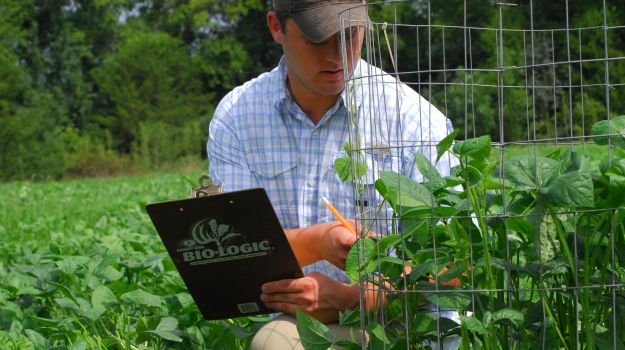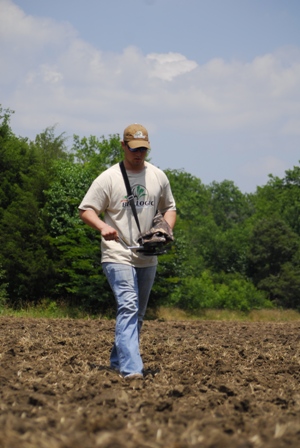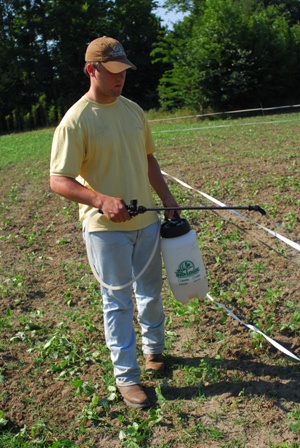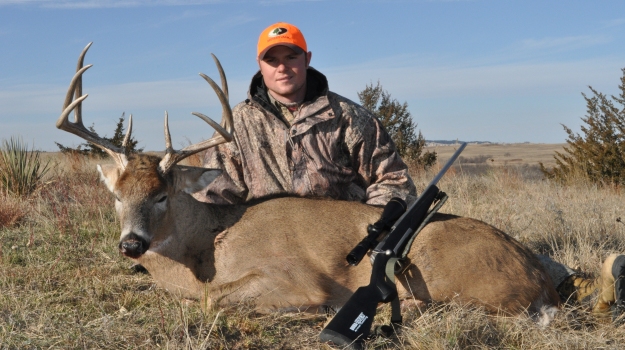Overseeing BioLogic Research Farm is a Learning Experience
By Neill Haas

This past growing season I had the educational, entertaining opportunity to oversee some work at one of our research farms in Mississippi. We test for many different things, searching for the best possible plants and products to bring to market. It makes a great opportunity to become a better hunter by learning more and being privy to some of the industry’s cutting edge technology. This past summer we had one particular five acre test plot that we used to collect up to date, detailed documentation concerning numerous characteristics about several of our spring/summer blends in addition to our P2 Plot Protector and a couple other new products like our new M.E.E.N. Green Fertilizer.
We obviously test for numerous growth characteristics like yield, palatability, shade and drought tolerance, best soil conditions and type, ease of planting and growth, herbicide performance and possibly most importantly deer utilization (do the deer like it).
 We planted BioMass, WhistleBack, BioMass all Legume and LabLab. The location we chose for our test plot is in an area of high deer density, so we knew we were going to have a great opportunity to test our P2 Plot Protector kit and watch it work under heavy pressure. One advantage we were going to have in planting in this location was the soil type. It lies in an area of Mississippi with very fertile black-dirt and a recently tested alkaline pH of 7.8. We also planned to use this area to test a new foliar application fertilizer we have been working on called “M.E.E.N. Green” Utilization cages were installed on all blends to compare plant potential with browse pressure.
We planted BioMass, WhistleBack, BioMass all Legume and LabLab. The location we chose for our test plot is in an area of high deer density, so we knew we were going to have a great opportunity to test our P2 Plot Protector kit and watch it work under heavy pressure. One advantage we were going to have in planting in this location was the soil type. It lies in an area of Mississippi with very fertile black-dirt and a recently tested alkaline pH of 7.8. We also planned to use this area to test a new foliar application fertilizer we have been working on called “M.E.E.N. Green” Utilization cages were installed on all blends to compare plant potential with browse pressure.
The conditions at planting time were ideal. The test field was in spring re-growth from some of our cool season annuals planted the previous fall. We used a quart per acre of 41% glyphosate to treat the area and get a good burn-down. After a couple of rains we were able to get in and go over the field several times with a heavy disk to work up a good seed bed. In reviewing our soil test, we decided to use a custom blend of bulk fertilizer with an NPK ratio of 8-24-24. No lime was needed with a current pH of 7.8.
Unfortunately several weeks after we planted, like many throughout the country, we were hit by a bad drought. However, since this was a “test plot” this enabled us to record how the plants did under adverse conditions, we got to see how well the plants did in these dry conditions. While moisture did improve for most of Mississippi, it showed us how these seeds/plants faired through germination, during lag phase and the most crucial early stages of growth.
The high deer density gave us a chance to see how well P2 Plot Protector faired in several tests. The P2 Kit comes with enough tape to go around one acre of ground and enough liquid to treat the tape three times which should be enough for 60 to 90 days. For maximum results we suggest treating the tape every 20-30 days. We taped off a 20 yard by 20 yard area in the middle of the test plot with the P2 ribbon and still to date the deer haven’t touched that spot.
For people trying to grow food plots in areas with high deer densities, it is a necessity to protect plots from over-browsing. Young plants such as soybeans, peas, and lablab are highly susceptible to over-browsing in their early stages of growth and it usually results in the death of the plant. The P2 Plot Protector Kit can guard your crop until you feel it has enough growth to handle the browse pressure or you feel like allowing entrance.
 While we didn’t have any problems with our P2 set-up, I have a couple hints from using it before. If you have a breach in the perimeter make sure you mend it ASAP. A hungry whitetail can be very persistent and if one finds a “chink in your armor” the “flood gates will open” if you don’t do something. So bolster any breaches with one or two extra offset strand(s) of ribbon. And probably the reason why we didn’t have a breach is because we gave our herd a portion of the plot. If they have some, they are MUCH less likely to try and find their way into your protected area. One last tip; for the first application of the P2 formula, some like to soak the ribbon rather than spray it on. This way the formula goes a lot further and every square inch of the ribbon receives optimum coverage. After the first application, spraying it on works very well, but soaking the ribbon saturates it for maximum effectiveness.
While we didn’t have any problems with our P2 set-up, I have a couple hints from using it before. If you have a breach in the perimeter make sure you mend it ASAP. A hungry whitetail can be very persistent and if one finds a “chink in your armor” the “flood gates will open” if you don’t do something. So bolster any breaches with one or two extra offset strand(s) of ribbon. And probably the reason why we didn’t have a breach is because we gave our herd a portion of the plot. If they have some, they are MUCH less likely to try and find their way into your protected area. One last tip; for the first application of the P2 formula, some like to soak the ribbon rather than spray it on. This way the formula goes a lot further and every square inch of the ribbon receives optimum coverage. After the first application, spraying it on works very well, but soaking the ribbon saturates it for maximum effectiveness.
The results from testing our new fertilizer were excellent. We are excited about this new product which is a water-soluble fertilizer with a 15-40-5 analysis. It can be sprayed on foliage or on bare ground that is to be planted. We used a Chapin Outfitter’s hand sprayer to apply M.E.E.N. Green on a few small sections of the test plot to document the growth difference in the treated vs. untreated area. The areas we applied the fertilizer had some obvious differences that were especially noticeable during the dry spell. Root development was significantly better in the treated areas which resulted in heavier and larger leaf production on all the legumes as well as more height in the sorghums and millets.
The stand-outs were BioMass all Legume and WhistleBack. The BioMass all Legume did best overall. The entire section is nothing but stems accept for the utilization cage where it is about 4 or 5 feet tall. The biggest fail was the amount of weeds. Parts of the test plot were a real problem, but with the early, hot dry spring we expected this. I guess we just didn’t react as well as we should have and maybe should have done a better job of killing the native bank before we planted. But as far as the browsing pressure, the Biomass all Legume was annihilated – it was a great success.



























